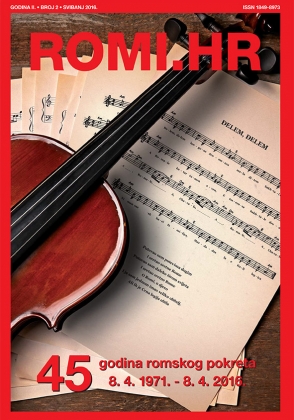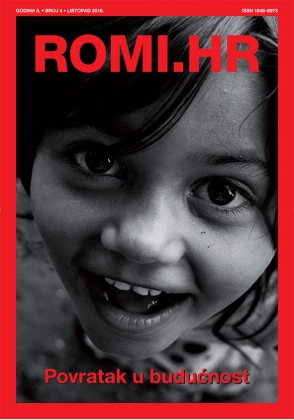Zanimljivosti ROMI.HR
/Đurđevdan i Ederlezi su za mnoge sinonimi.
Ederlezi odnosno Hidirellez dolazi iz Turske, a kako i zašto možete saznati ovdje.
Prijevod: Melike Sariguel
6. svibanj, simbol pročišćenja i ponovnog rađanja prirode, praznik je u kojem se slavi dolazak proljeća. Budući da 6. svibnja čini veliki dio romske tradicije, potrebno je objasniti odnos Roma prema tom danu s kojim se Romi poistovjećuju i koji donosi radost i koji rezultira s najživopisnijim scenama rituala kroz stoljeća.
Godina ima svoje faze, kao i svako živo biće na planetu koje oživi, raste i na kraju umire. Proljeće je simbol rađanja. Faza rasta odvija se ljeti, a zatim se nastavlja prema zrelosti koja dolazi u jesen, a zima je sezona spavanja. Poanta je u tome što se proljeće razlikuje od ostalih godišnjih doba jer rađa, donosi svježinu, toplo vrijeme i predstavlja znak za nove stvari koje dolaze. Zbog toga proljeće stoljećima okuplja različite narode pod istim krovom kako bi proslavili i pozdravili ovu sezonsku promjenu. 6. svibanj posvećen je proslavi buđenja, procvata prirode širom balkanskih zemalja, Srednje Azije, Bliskog Istoka, Anadolije i mnogih drugih regija koja imaju četiri godišnja doba.
Ovaj proljetni dan, 6. svibnja, stavljen je na dnevni red UNESCO-a od 2010. godine, pokrenut zajedničkim naporima Turske i tadašnje Makedonije kako bi ga učinili dijelom Popisa nematerijalne kulturne baštine, i konačno je svoje mjesto na tom popisu dobio 2016. godine. Ovaj proljetni festival, koji se od pred islamskog doba u Turskoj doživljava kao zajedničko naslijeđe unutar Anadolije i Mezopotamije, obilježava se u noći 5. na 6. svibnja. Postoje glinene pločice s kraja 3000. godine prije Krista, koje pokazuju da su se u gradu Ur u Mezopotamiji početkom proljeća izvodili veličanstveni rituali u ime božanstva Tammuza (Dumuzi), mezopotamskog boga plodnosti, koji simbolizira vitalnost rijeka Eufrat i Tigris koje su okruživale i ozeljenavale mezopotamsku ravnicu.
Vremenom je 6. svibanj uljepšan islamskim motivima i postao vrlo značajan u turskom društvu. Vjeruje se da je, na današnji dan, prorok Hidir, koji simbolizira izvor blagostanja, pomaže potrebitima da prevladaju nedaće i kažnjava loše ljude, upoznao proroka Ilijasa. Vjeruje se da na dan kada se ova dva proroka, Hidir i Ilijasa (Ilija) jednom godišnje sretnu, sve želje se ostvare.
Hidirellez, koji se ne može pripisati jednoj kulturi, obilježava se u Turskoj ritualima i ceremonijama posvećenima Hidiru i Ilijasu, koji su zaštitnici životinja i biljaka i za koje se vjeruje da donose prosperitet obitelji i društvu, i povećavaju bogatstvo. Za ovu sezonsku promjenu, koja je Ederlezi za Rome, kako je predstavljena u Kusturičinom filmu „Dom za vješanje“, a Hidirellez za Tursku, izvedena iz „hıdırlık“ što na starom turskom znači livada, pripreme započinju nekoliko dana ranije, a proslave mogu trajati čak i danima. Legenda kaže da prorok Hidir ne bi posjećivao neuredna mjesta, zbog čega je prvo i najvažnije što treba učiniti prije 6. svibnja generalno čišćenje.

Iako se proslave Hidirelleza razlikuju od regije do regije u Turskoj, postoje neke uobičajene tradicije koje potječu iz starih vremena. Pješačenje po prirodi, organiziranje festivala i zabava, pripremanje posebne hrane, naročito jela od riže, specifična za pojedinu regiju, janjetinu, zatim biti dobro obučen, posjetiti i darivati rodbinu, paliti vatru i tri je puta preskakati, davati milostinju, posjećivati svetišta, grobnice i turbete, izgovarati molitve, žrtvovati životinje u ime proroka Hidira, valjati se po travi i poželjeti zdravlje, sreću i prosperitet neke su od starih i sve prisutnih tradicija koje se mogu vidjeti u skoro svim regijama.
U smislu regionalnih rituala, na primjer, u Čanakkaleu, navečer 5. svibnja, grah se zakopava ispod grma ruže. Vjeruje se da će se želja ostvariti ako grah pozeleni prije nego sunce ne izađe. U Bursi se vrećica puna novca stavlja ispod grma ruže, a nakon 6. svibnja tu vrećicu bi trebao sa sobom nositi njezin vlasnik radi blagostanja i plodnosti. U Istanbulu ljudi više vole biti vani i u prirodi i vjeruju da će se želje obješene na grm ruže ostvariti i da će se bolesti izliječiti. U Antaliji i mnogim drugim regijama ritual je spremanje beskvasnog jogurta, ostvarenje želja ovisi o uspjehu u spremanju jogurta. U Izmiru se želje crtaju na pijesku ili okače na drvo želja. Također, uobičajeno je sakupljati neke biljke i vješati ih na pragove dovratke.
Najizvrsnija praksa 6. svibnja u Turskoj je ostavljanje otvorenih poklopaca spremnika s hranom i vrata skladišta, i ostavljanje vrećica s novcem otvorenim, crtanje malog modela onoga što žele tog dana - automobila, kuće, fakultetskih diplome itd. na papiru u noći 5. na 6. svibnja i objesiti ih na grm ruže uz pomoć crvenom vrpcom, s vjerovanjem da će im Hidir pomoći. Što je najvažnije, želje se moraju držati u tajnosti kako bi se ostvarile.
Što se tiče načina na koji Romi slave dolazak proljeća, ova godišnje doba, koje ima veliko značenje za Rome, vrijeme je okupljanja svih romskih zajednica širom svijeta, nakon što su bili razdvojeni tokom jeseni i zime. Romi bi se razdvojili nakon ljeta jer bi imali poteškoća da osiguraju osnovne potrebe svima u zajednici ako bi živjeli svi zajedno. Razlog zbog kojeg su izabrali svibanj za termin sastanka je taj što na Balkanu i u Anadoliju, nakon početka svibnja, mala je šansa da padne snijeg. Na ovim okupljanjima su međusobno razmjenjivali iskustava o onom što su doživjeli od zadnjeg susreta, a druženja su se odvijala u festivalskoj atmosferi. U skladu s tim, u Jedreneu, gradu s jednom od najvećih populacija Roma u Turskoj, proslave Hidirelleza održavaju se na otvorenom, s lokalnim godišnjim natjecanjem pod nazivom Kırkpınar Hrvanje, koje potječe od prvog hrvanja koje je održano na dan Hidirelleza.
Proslava koju su Romi sa sobom donijeli iz Indije naziva se praznik Kakava, koji je danas integriran s praznikom Hidirellezom u Turskoj i gotovo je nemoguće utvrditi gdje jedan počinje i drugi završava. U pogledu rituala 6. svibnja, u Turskoj Romske tradicije dolaze u prvi plan sa svojim radosnim plesnim tradicijama koje započinju uvečer 5. svibnja i traju do večeri 6. svibnja. Šestog svibnja rijeka Marica (Meriç) u Jedrene prekrivena je papirnatim brodovima koji nose želje zapisane iz srca Roma, nakon toga slijedi skakanje preko vatre, kako bi se tokom cijele godine oslobodili „zlih očiju“. Štoviše, mlade djevojke koje se žele udati objesit će crvenu tkaninu na grm ruže ispod staviti prstenje. Također je uobičajeno vidjeti mlade djevojke kako stavljaju naušnice ili prstenje u keramičku posudu punu vode ili trave i ostavljaju je ispod stabla ruže.
Da zaključimo i kratko, doček proljeća, što simbolizira Hidirellez u Turskoj, a podudara se s Đurđevdanom u kršćanstvu po julijanskom kalendaru, praznik je u kojem se društvo može vidjeti svoj odraz u drugim društvima, okuplja svjetove muslimana i pravoslavnih kršćana, jača partnerstva, veliča ljepotu prirode i stvara dobar razlog za proslavu dolaska proljeća u različitim dijelovima svijeta, a opet zajedno, u interakciji kultura.
Dobrodošlo nam proljeće i sretan 6. svibanj - Ederlezi / Đurđevdan!
Hıdırellez Bayramınız kutlu olsun!

6th of May, the symbol of purification and rebirth of nature, is a holiday in which the coming of spring is celebrated. Since the 6th of May has been a great part of Roma traditions, it is impossible to overlook this day’s relations to Roma, who are identified with the 6th of May as bringing cheerfulness and joy, and who create the most colorful scenes of celebration rituals for ages.
Seasons have their own symbolic purposes which could be identified as phases, just like every other living creature on the planet that comes to life, grows, and dies eventually. Spring is a symbol of birth. The growth phase takes place in summer, it continues as maturity in autumn and winter is the season of sleep. The point is, spring differentiates itself from the other seasons as giving birth, bringing freshness, warm weather, and being a sign for new things to come. That is why, for centuries, spring has been bringing together different nations under the same roof to celebrate and welcome this seasonal change. 6th of May is dedicated to the celebration of the awakening, blossoming of nature all over the Balkan countries, Central Asia, the Middle East, Anatolia, and many other regions that go through four seasons.
This Spring Day, 6th of May, has been on UNESCO’s agenda since 2010 as initiated by collaborative efforts of Turkey and Macedonia to make it a part of Intangible Cultural Heritage Lists, and finally made its place in that list in 2016. This spring festival, which has been regarded as a common heritage behind the gates of Anatolia and Mesopotamia since pre-Islamic times in Turkey, is celebrated on the night that connects May 5th to May 6th. There are clay tablets from the end of 3000 BC showing that magnificent rituals were performed in the city of Ur in Mesopotamia at the beginning of the spring season in the name of the deity Tammuz (Dumuzi) - Mesopotamian god of fertility - which symbolizes the vitality of the Euphrates and Tigris rivers that encircled and greened the Mesopotamian plain.
In time, the 6th of May has been embellished with Islamic motifs and strengthened its position in Turkish society. At this very date, it is believed that prophet Khidr, who symbolizes the source of prosperity, helps the ones in need to overcome the struggles, and punishes the bad people, had met the prophet, Elisha. The day that these two prophets, Khidr and Elisha meet once a year, is believed to make wishes come true.
Hidirellez, which cannot be attributed to a single culture, is celebrated in Turkey with rituals and ceremonies dedicated to Khidr and Elisha, who are protectors of animals and plants that are believed to bring prosperity to the families and society and increase fertility. For this seasonal change, which is Ederlezi for Roma people as presented in Kusturica’s “Time of the Gypsies”, called as Hidirellez in Turkish, derived from ‘hıdırlık’ which means a meadow in old Turkish, preparations start a few days earlier and celebrations can last even for days. Legend has it that the prophet Khidr wouldn’t prefer to visit messy places, which forms a basis for the first and most important thing to do before the 6th of May: an overall cleaning.
Although Hidirellez celebrations differ from one region to another in Turkey, there are some common traditions that date back to old times. Hiking in the wilderness, organizing festivals & entertainments, preparing special food - in particular, rice dishes specific to regions -, eating lamb meat, paying attention to the outfit, visiting relatives & giving presents, lighting a fire & jumping three times over it, alms-giving, visiting shrines, tombs, & turbes, praying, sacrificing animals - making a vow in the name of prophet Khidr -, wallowing on grass, and making wishes for health, happiness, & prosperity are among these old and common traditions that could be seen in almost every region.
In terms of regional rituals, for example, in Çanakkale, in the evening of May 5, beans are buried under the rose tree. It is believed that if the beans turn green until sunrises, the wish will come true. For Bursa, a bag full of money is placed under the rose tree and after the 6th of May, the bag should be carried by its owner for prosperity and fruitfulness. In Istanbul, people prefer to be out in nature as well and they believe that the wishes hung on a rose tree will come true and the diseases will be healed. In Antalya and many other regions, the ritual is trying to make unleavened yogurt and the course of wishes is dependent on this yogurt’s success. In Izmir, the wishes are either drawn on sand or hung on a wish tree. Also, it is common to collect some plants and hang them on the door sills.
The most outstanding practices of the 6th of May in Turkey are leaving the caps of food containers, doors of warehouses open, and loosening the strings of money bags, drawing a small model of what they wish for that day - a car, a house, a degree at university, etc. - on a paper on the night of May 5, with the belief that Khidr will help them, and hanging them under the rose tree with a red ribbon. Most importantly, the wishes must be kept as a secret in order to make them real.
Regarding the way Roma celebrates the coming of spring, this season, bearing a huge meaning, has been a gathering time for all Roma communities around the world, after being apart throughout autumn and winter. Roma people would split apart after summer as they would have shortages to provide basic needs for everyone in the community if they were to live all together. The reason they chose May as the meeting period is that, after May, in and around the Balkans, there would be almost no snow. These gatherings would be based on sharing each other’s experiences since they’d last seen each other and meetings would take place in a festival atmosphere. Accordingly, in Edirne, a city with one of the highest populations of Roma in Turkey, Hidirellez celebrations are held in an open-air with a local annual competition called Kırkpınar Wrestlings, which rely upon the first wrestling that took place on a Hidirellez day.
Actually, the celebration that Roma carried with themselves from India is called Kakava Holiday, which is so integrated with Hidirellez in Turkey today that it is almost impossible to trace the origin of the practices. In terms of rituals of the 6th of May, Roma people come to the forefront with their joyful dance traditions that begin on the 5th of May and last almost a full day. On the 6th of May, the Evros River in Edirne is covered with paper ships carrying the wishes that are put down on paper from Roma people’s hearts, which is followed by jumping over the fire to be freed from evil eyes throughout the year. Moreover, young girls who desire to get married will hang red clothes on a rose tree and put rings on the bottom of the tree. Also, it is common to see young girls put earrings or rings into a ceramic jar full of water or greenery and leave it underneath a rose tree.
The long and the short of it, the welcoming of spring, which means Hidirellez in Turkey, and coincides with St. George’s Day in Christianity in Julian Calendar, in which a society can see itself in other societies, brings together the Muslim and Orthodox Christian worlds, reinforces partnerships, glorifies the beauty of nature and creates a good reason to celebrate the coming of spring in different parts of the world and yet, together in cultural interaction.
Welcome spring and happy 6th of May!
Hıdırellez Bayramınız kutlu olsun!
 Povratak na zanimljivosti
Povratak na zanimljivosti













